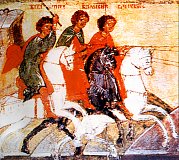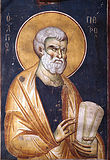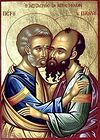

| Previous day | Next day |
| Old Style
January 16
|
Saturday |
New Style
January 29
|
| 32nd Week after Pentecost. Tone 6. | No fast.
|
![]() Veneration of the Precious Chains of the Holy and All-glorious Apostle Peter.
Veneration of the Precious Chains of the Holy and All-glorious Apostle Peter. ![]() Blessed Maximus, priest of Totma (Vologda), fool-for-Christ (1650).
Blessed Maximus, priest of Totma (Vologda), fool-for-Christ (1650).
Martyrs Speusippus and his brothers Eleusippus and Meleusippus, their grandmother Leonilla, and with them Neon, Turbo, and Jonilla (Jovilla), in Cappadocia (161-180). Martyr Danax the Reader, in Macedonia (2nd c.). St. Honoratus, archbishop of Arles and founder of Lerins Monastery (429).
St. James of Tarentaise (429). Martyr Sigebert, king of the East Angles (635). St. Fursey, Irish missionary monk of Burgh Castle (East Anglia), Lagny, and Peronne (Gaul) (650). St. Romilus the Sinaite, of Ravanica Monastery (Serbia) (1375). St. Gerasimus II, patriarch of Alexandria (1714). New Hieromartyr Damascene of Gabrovo, hieromonk of Hilandar, at Svishtovo (1771). New Hieromartyr Nicholas, priest, of Mytilene (1777).
Repose of Elder Theodore of Irkutsk (1923) and Priest Demetrius Gagastathis of Platanos, Trikala (1975).
Thoughts for Each Day of the Year
According to the Daily Church Readings from the Word of God
By St. Theophan the Recluse

Saturday. [Col. 1:3-6; Luke 16:10-15]
Ye cannot serve God and mammon. A divided thought and divided heart make a person unfit for anything; for A double-minded man is unstable in all his ways (James 1:8). He either does nothing, or does and redoes; that is, he builds with one hand and destroys with the other. The source of a truly God-pleasing life is a firm resolution to please God in all things. This resolution directs all of a person’s thoughts, desires and feelings toward one thing, and thus uniting his inward [powers], it makes him strong to do deeds, bringing unity into all of his activities and imparting to them a single character. Such deeds are successful and fruitful, because they are full of true life. Where do inertia, immobility and fruitlessness of deeds come from? From inner lifelessness; and inner lifelessness comes from inner division. One single goal is not acknowledged or established as a law of life—deeds are performed haphazardly. Therefore one deed goes in its direction, another goes in another direction, and the edifice of one’s life is never erected. Choose a goal and devote your life to it. The true, main goal is indicated by the God-like nature of man; it is living communication with God. Direct also toward this main goal all personal, scholarly, worldly, civic, commercial, official, and governmental goals. If everyone in society held to this [principle], there would be one general tenor to society, and one spirit would fill everyone.
Articles
 The Holy Glorious and All-Praised Leaders of the Apostles, Peter and PaulSermon of Saint Augustine, Bishop of Hippo |
 Blessed Maximus the Fool-for-Christ of Totma, VologdaBlessed Maximus, Priest of Totma, was for a certain time, a priest in the city of Totma in the Vologda diocese. |
 Martyr Danax the Reader, in MacedoniaThe Holy Martyr Danax lived during the second century and served as reader at a church in Auleneia in Macedonia. |
 St. Honoratus the Archbishop of Arles and Founder of Lerins MonasterySaint Honoratus was born in Gaul (modern France) about 350, and came from a distinguished Roman family. |
 Venerable Romilus of RavenicaSaint Romilus the Hesychast was the disciple of Saint Gregory of Sinai (August 8). He was born in Vidin, Bulgaria of a Greek father and a Bulgarian mother. |









